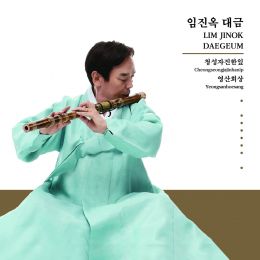대금 독주곡 <청성자진한잎>은 가곡 태평가를 변주한 곡이다. 청성은 높은 음을 말하며 자진한잎은 가곡 형태에 기반을 둔 관악곡이다. 대금의 높은 음과 맑은 소리를 유감없이 보여주는 곡으로 간단히 줄여 청성곡이라고도 한다. 음악의 구조는 전통가곡 형식을 가지고 있고, 일정한 선율이 있지만 연주자의 개성에 따라 선율의 가변성이 있는 곡이다.
영산회상
<영산회상>은 오늘날 전승되는 풍류음악의 대표적인 기악곡이다. <영산회상>이 언제부터 연주되었는지 정확히 알수는 없으나 AD1500년대에는 성악곡으로 연주되었고 AD1680년에는 기악곡으로 연주되기 시작하였다. 이와 같은 <영산회상>의 기악화는 궁중에서 민간으로 <영산회상>의 향유공간이 확대되면서 생겨난 변화로 볼 수 있다. 기악화 된 이래 <영산회상>의 음악적 발전은 가속화되었는데 <상령산>에서 여러 파생곡들이 출현하게 된다. <영산회상>은 <상령산>, <중령산>, <세령산>, <가락덜이>, <상현도드리>, <하현도드리>, <염불도드리>, <타령>, <군악> 등 아홉 곡의 모음곡이 되었다. <영산회상>은 어떤 한 사람이 작곡한 것이 아니라 여러 연주자들의 오랜 기간동안 연주활동의 결과물과 같은 연주자들의 음악이라고 생각한다. 음악의 속도는 처음에는 느리게 시작하여 조금씩 빨라지는 이른바 <느림-보통-빠름>의 구조를 가지고 있다. <영산회상>의 전체적 악상은 절제의 표현력이라고 생각한다.
Cheongseongjajinhanip
Cheongseongjajinhanip for daegeum solo is a variation of the song “Taepyeongga” from gagok, the long lyric song cycle. Cheongseongjajinhanip can be abbreviated as Cheongseonggok. “Cheongseong” refers to notes in a high pitch range while “jajinhanip” indicates a piece for wind instruments derived from the long lyric song cycle. It is a piece that beautifully demonstrates the high tone and clear sound of the daegeum. The structure of the music follows that of the original song, and has a certain melodic line; however, the melody could be varied according to the individuality of each performer.
Yeongsanhoesang
Yeongsanhoesang is a representative instrumental piece of pungnyu music (aristocrats’ music) handed down today. It is not known exactly when Yeongsanhoesang was first performed, but it was played as a vocal piece in the 1500s and started to be performed as an instrumental piece in 1680. The instrumentalization of Yeongsanhoesang can be seen as a change brought about with the expansion of musical spaces from the court to the private sector. Since becoming an instrumental piece, the musical development of Yeongsanhoesang accelerated, and several pieces derived from “Sangnyeongsan” appeared. Yeongsanhoesang became a suite of 9 pieces consisting of “Sangnyeongsan,” “Jungnyeongsan,” “Seryeongsan,” “Garakdeori,” “Sanghyeondodeuri,” “Hahyeondodeuri,” “Yeombuldodeuri,” “Taryeong,” and “Gunak.” I believe that Yeongsanhoesang was not composed by any particular person. Rather, it is the music of performers, the result of many players’ long-term performing activities. The tempo of the music has a so-called “slow-moderate-fast” structure that starts slowly and gradually increases. The overall musical mood of the piece could be described as restrained-expressiveness. ....
 ....
.... 





